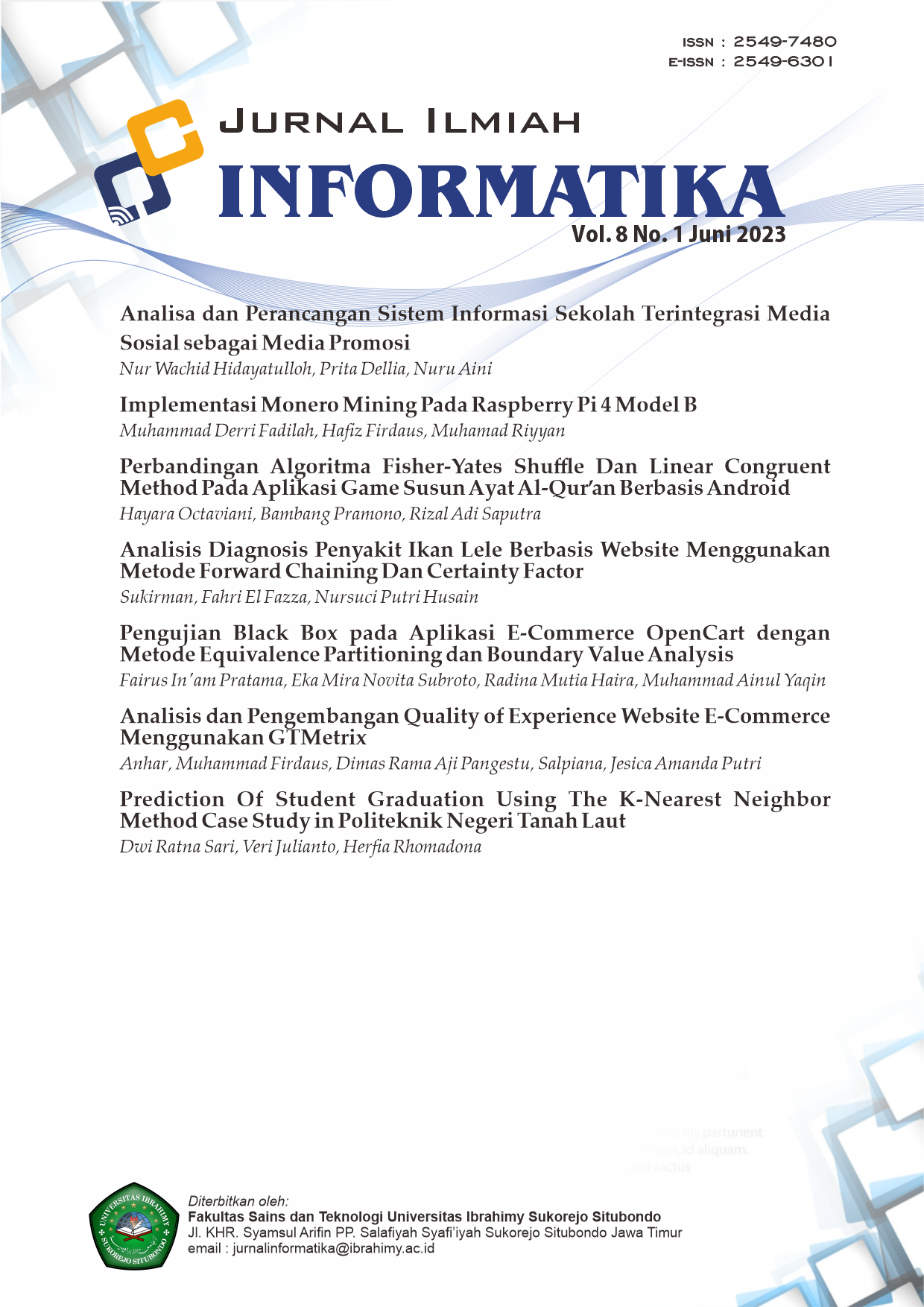Prediction Of Student Graduation Using The K-Nearest Neighbor Method Case Study in Politeknik Negeri Tanah Laut
DOI:
https://doi.org/10.35316/jimi.v8i1.74-88Keywords:
K-Nearest Neighbor, Prediction, Student, Website, GraduatedAbstract
Tanah Laut State Polytechnic as one of the universities in Indonesia has definitely paid attention to the quality of its students. One way is to predict student graduation. Graduation predictions can help study programs and academic supervisors review and pay special attention to students, especially students who are predicted to not graduate on time. Realizing one way to pay attention to the quality of students can be realized by creating a Student Graduation Prediction system using the Web-Based K-Nearest Neighbor (KNN) Method. The K-Nearest Neighbors method is an object classification method based on training data by finding the nearest neighbor value to determine the class of the new data. In the Student Graduation Prediction using the K-Nearest Neighbor Method, there is a section that can process training data, test data, the process of calculating student graduation predictions, and displaying the results obtained from the KNN calculation which has two classification classes, namely graduated and not passed. Based on the results of the study, it was found that KNN with different k values obtained different levels of accuracy, data testing with a value of k=1 obtained an accuracy rate of 83.33%, the value of k=2 obtained an accuracy rate of 79.17%, the value of k=3 to k= 8 obtained an accuracy rate of 95.83%, and the values of k=9 and k=10 obtained an accuracy rate of 91.67%. It can be concluded that the test with a value of k=3 to k=8 obtained the best or highest level of accuracy.
Downloads
References
A. Yandi Saputra and Y. Primadasa, “Penerapan Teknik Klasifikasi Untuk Prediksi Kelulusan Mahasiswa Menggunakan Algoritma K-Nearest Neighbour Implementation of Classification Method to Predict Student Graduation Using K-Nearest Neighbor Algorithm,” Techno.COM, vol. 17, no. 4, pp. 395–403, 2018.
L. A. R. Hakim, A. A. Rizal, and D. Ratnasari, “Aplikasi Prediksi Kelulusan Mahasiswa Berbasis K-Nearest Neighbor (K-NN),” JTIM J. Teknol. Inf. dan Multimed., vol. 1, no. 1, pp. 30–36, 2019, doi: 10.35746/jtim.v1i1.11.
R. A. Manullang and F. A. Sianturi, “Penerapan Algoritma K-Nearest Neighbor Untuk Memprediksi Kelulusan Mahasiswa: Bahasa Indonesia,” J. Ilmu Komput. Dan …, vol. 4, no. 2, pp. 42–50, 2021.
M. A. A. Candra and I. A. Wulandari, “Sistem Informasi Berprestasi Berbasis Web Pada Smp Negeri 7 Kota Metro,” J. Mhs. Ilmu Komput., vol. 01, no. 1, pp. 175–189, 2021, doi: 10.21856/j-pep.2021.4.08.
Y. A. Setianto, Kusrini, and Henderi, “Penerapan Algoritma K-Nearest Neighbour Dalam Menentukan Pembinaan Koperasi Kabupaten Kotawaringin Timur,” Creat. Inf. Technol. J., vol. 5, no. 3, pp. 232–241, 2019, doi: 10.24076/citec.2018v5i3.179.
Jasmir, D. Z. Abidin, S. Nurmaini, and R. F. Malik, “Penerapan Metode K-Nearest Neighbor dalam Memprediksi Masa Studi Mahasiswa (Studi Kasus : Mahasiswa STIKOM Dinamika Bangsa),” Comput. Sci. ICT, vol. 3, no. 1, pp. 133–138, 2017, doi: 10.51876/simtek.v4i2.56.
W. Yustanti, “Algoritma K-Nearest Neighbour untuk Memprediksi Harga Jual Tanah,” J. Mat. Stat. dan komputasi, vol. 9, no. 1, pp. 57–68, 2012.
N. Azwanti, “Sistem Informasi Penjualan Tas Berbasis Web Dengan Pemodelan UML,” Kumpul. J. Ilmu Komput., vol. 4, no. 6, pp. 2827–2839, 2017.
R. A. Sukamto and M. Shalahuddin, “Rekayasa Perangkat Lunak Terstruktur dan Berorientasi Objek,” Informatika Bandung. 2016.
M. Destiningrum and Q. J. Adrian, “Sistem Informasi Penjadwalan Dokter Berbassis Web Dengan Menggunakan Framework Codeigniter (Studi Kasus: Rumah Sakit Yukum Medical Centre),” J. Teknoinfo, vol. 11, no. 2, pp. 30–37, 2017, doi: 10.33365/jti.v11i2.24.
M. D. Irawan, Y. H. Siregar, S. T. A. Tambunan, and M. A. Ardika, “Penerapan Metode Simple Additive Weighting dalam Menentukan Perguruan Tinggi Negeri,” vol. 8. pp. 12–23, 2022.
I. A. A. Angreni, S. A. Adisasmita, M. I. Ramli, and S. Hamid, “Pengaruh Nilai K Pada Metode K-Nearest Neighbor (Knn) Terhadap Tingkat Akurasi Identifikasi Kerusakan Jalan,” Rekayasa Sipil, vol. 7, no. 2, pp. 63–70, 2018.







